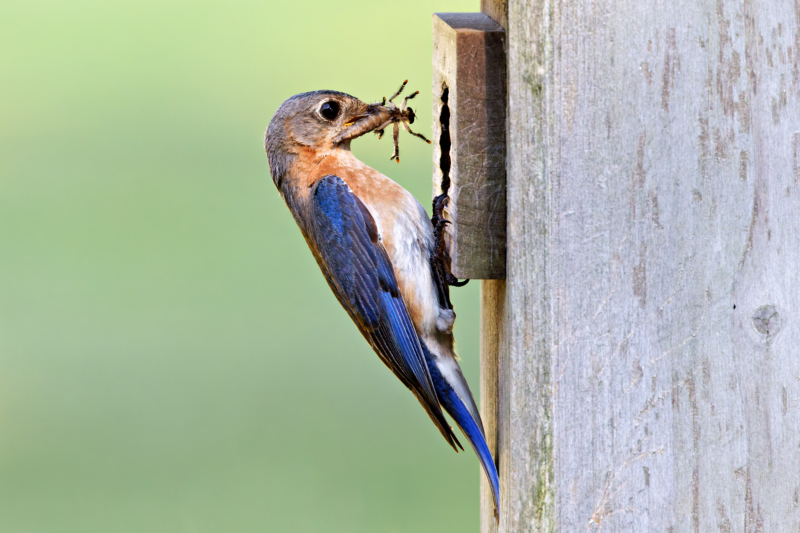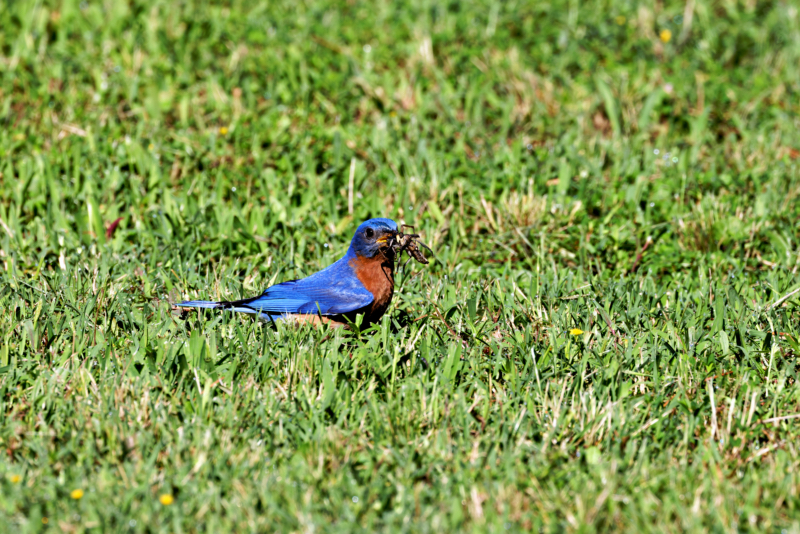In my previous post, “A Sneak Peek at the New Generation: Eastern Bluebird Chicks,” I shared some adorable photos of the little ones in my backyard birdhouse. But there’s a fascinating story behind the scene of that picture!
Just before I snapped the photo, the male bluebird arrived at the house with a rather unexpected offering for his hungry offspring: a Robber Fly. This wasn’t the first time I’d witnessed this surprising prey choice. It left me wondering – what on earth are these bluebirds feeding their chicks?

Intrigued, I dove into some online research to see if bluebirds, or birds in general, were known for catching Robber Flies.
Here’s what I found:
Yes, birds can catch Robber Flies. Robber Flies, known for their aggressive predatory behavior and impressive flying skills, can still fall prey to birds. Here’s a closer look at how this interaction unfolds in nature.
Eastern Bluebird: The Agile Insectivore
Eastern Bluebirds are small thrushes that primarily feed on insects, especially during the breeding season when they need to provide high-protein food for their chicks. Here are some key characteristics that make them capable hunters:
- Keen Eyesight: Bluebirds have excellent vision, which allows them to spot insects from a distance.
- Agile Flight: They are skilled flyers, capable of quick, darting movements to catch prey.
- Perch Hunting: Eastern Bluebirds often hunt from a perch, waiting patiently before swooping down on their target.
Robber Flies: Formidable Prey
Robber Flies (family Asilidae) are known for their aggressive hunting tactics and can be challenging prey due to their speed and agility. They have a formidable appearance with long legs, a sturdy body, and a bristly face. Despite this, they can still fall victim to skilled bird hunters.
The Hunt: Bluebird vs. Robber Fly
Here’s how an encounter between an Eastern Bluebird and a Robber Fly might unfold:
- Spotting the Fly: The bluebird, perched on a fence post or tree branch, uses its keen eyesight to spot the Robber Fly either resting or flying nearby.
- Strategic Approach: The bluebird might observe the fly for a moment to assess its movements.
- Quick Maneuver: With a sudden burst of speed, the bluebird launches itself from the perch.
- Aerial Pursuit: If the Robber Fly takes flight, the bluebird uses its agility to chase and catch the fly mid-air.
- Capture and Consumption: The bluebird grabs the Robber Fly with its beak, then returns to a perch to eat it.
Why Eastern Bluebirds Eat Robber Flies
- Nutritional Value: Robber Flies, like other insects, provide a good source of protein, essential for the bluebird’s diet, especially during the breeding season.
- Abundant Prey: Robber Flies are often abundant in the bluebird’s habitat, making them accessible prey.

Conclusion
Eastern Bluebirds are more than capable of catching and eating Robber Flies, thanks to their sharp eyesight, agile flight, and strategic hunting tactics. This interaction is a testament to the bluebird’s role as a proficient insectivore in its ecosystem. Next time you’re out in the field, keep an eye out for these beautiful birds—you might just witness them in action, turning a fearsome Robber Fly into their next meal.

super interesting info and super interesting presentation!
I’m really enjoying your blog, Steve!
Awesome! Thank you!